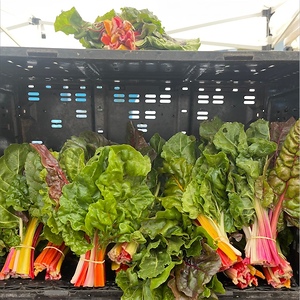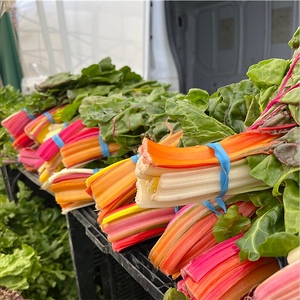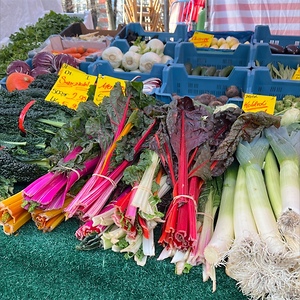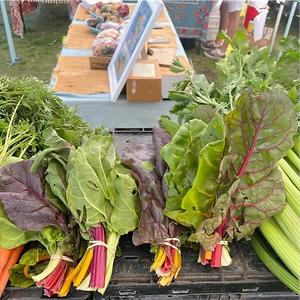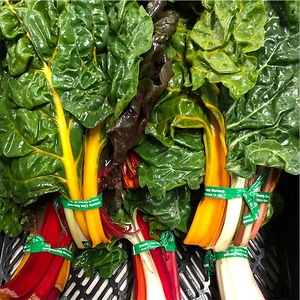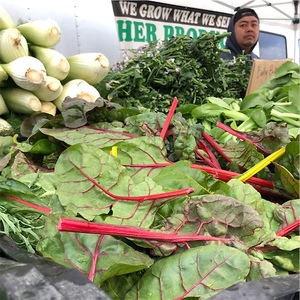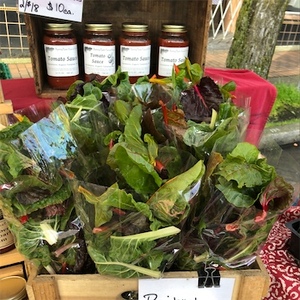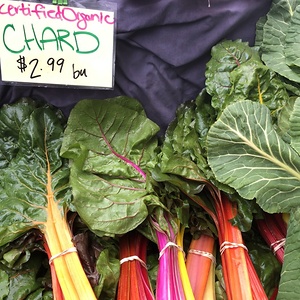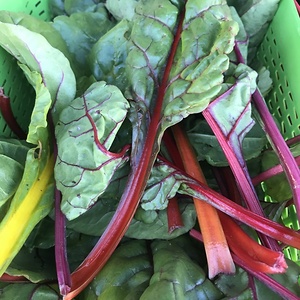


Rainbow Baby Swiss Chard
Estimated Inventory, lb : 0
Description/Taste
Baby Rainbow Swiss chard is distinguished by its myriad of colors including gold, pink, orange, purple, red, and white with bright and pastel variations. Depending upon the stage of growth at which the plants are harvested, leaves may be completely flat or slightly wrinkled. The leaves grow upright from a dense rosette of ribbed stems, sprouting leaves in shades of green and deep burgundy. Baby Rainbow Swiss chard has subtle earthy flavors and mild salty characteristic with a tender succulent texture.
Seasons/Availability
Baby Rainbow Swiss chard is available year-round.
Current Facts
Baby Rainbow Swiss chard are the young immature leaves of Beta vulgaris subsp. cicla var. Flavescens in a variety colors. Ranging from gold, to orange, red and magenta, the seeds are sold in a mix collectively known as “Bright Lights”, “5-color Silverbeet” or “Electric Rainbow”. Their brilliant pigmentation is due to Betalains which are nitrogen-containing water-soluble compounds that are found only in a limited number of plant lineages. To the naked eye they are simply pigments of red and yellow hues. But in nature, these betalains act as a source of survival, protecting the plant from UV rays while also attracting insects and bees for pollination.
Nutritional Value
Baby Rainbow Swiss chard is full of dietary fiber for maintaining a healthy digestive tract. It is an excellent source of vitamin B6, C, E and K, carotenes, calcium, protein, thiamin, niacin and folic acid. It also contains betalain, a pigment that has repeatedly been shown to support activity within the body's detoxification process, eliminating unwanted toxic substances. Betalains are not heat-stable, though, so longer cooking times can decrease their presence.
Applications
Baby Rainbow Swiss chard should be eaten raw or just lightly cooked so as to preserve their brilliant color and delicate texture. Use the young raw leaves to add an earthy saltiness to green salad mixes. Gently sauté the entire stalk and compliment with garlic, smoked meats and white beans. Wilt the shredded leaves into pastas or atop pizzas and flatbreads. The stalks of larger plants are equally edible as the leaves, and may be used in dishes for added texture. Complimentary flavors include citrus, tomatoes, garlic, shallots, chickpeas, white beans, potatoes, aged and melting cheeses, cream, mushrooms, bacon, sausage, ham, chili flakes, golden raisins, pine nuts, fennel and herbs such as basil, tarragon and chervil.
Ethnic/Cultural Info
The word "Swiss" was used to distinguish chard from cardoon, or artichoke (Cynara cardunculus) in French seed catalogs. Apparently the seeds of both plants were sold under the same names, and the “Swiss” moniker stuck, becoming a universal label we know today.
Geography/History
As its genus, Beta vulgaris, suggests, chard is, in fact, a beet that has been chosen for leaf production at the expense of root formation. All chard varieties are descendants of the sea beet (B. maritima), a wild seashore plant found growing along the Mediterranean and Atlantic coasts of Europe and North Africa. Documentation of Rainbow Swiss chard cultivation dates back to 1636 within the book "The Herball or General History of Plantes", however commercial exposure to Rainbow Swiss chard wasn't until the 19th Century. It is easily adaptable to many soil types and a prolific producer in full sun or partial shade. When harvested as an immature plant intended for raw eating, it is best to discard the outer leaves, retaining only the small tender inner leaves.
Recipe Ideas
Recipes that include Rainbow Baby Swiss Chard. One
| The Vintage Mixer |
|
Swiss Chard and Ricotta Cakes |
| Food dot com |
|
Baby Swiss Chard With Bacon, Pine Nuts and Raisins |



